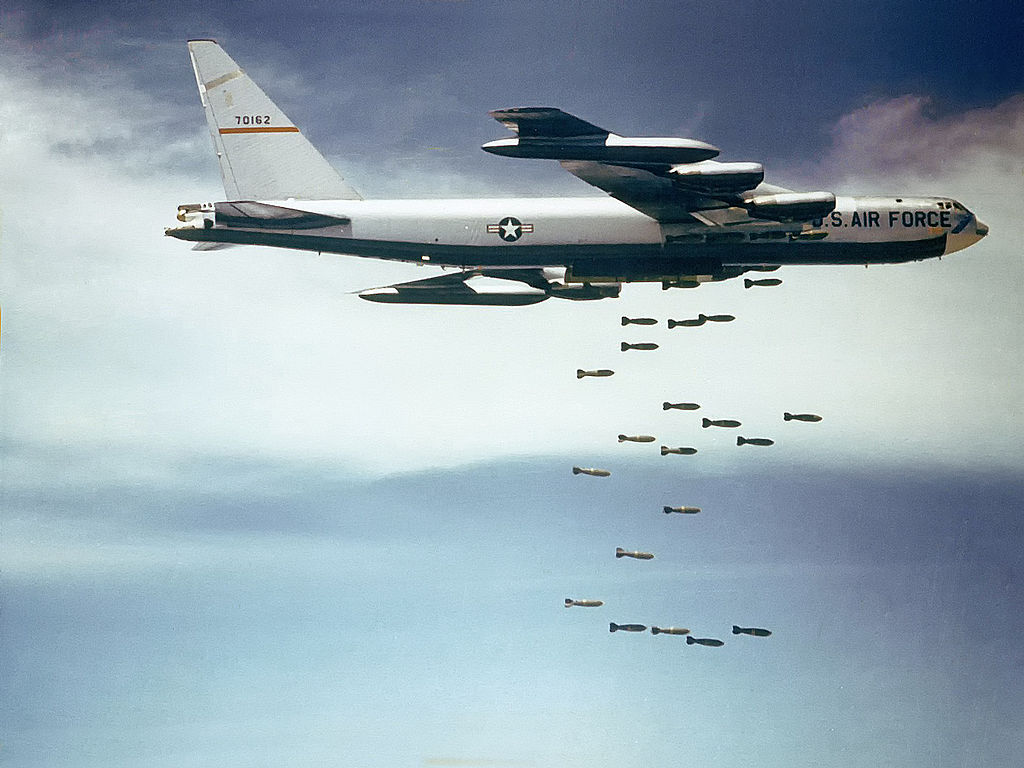 |
| Secret Bombing of Cambodia |
At the height of the Vietnam War U.S. bombers were secretly ordered to bomb what were believed to be strategic targets in neutral Cambodia. The existence and extent of those missions were officially denied and covered up at the highest levels for several years.
Cambodia emerged from French colonial rule in 1953 under the leadership of Prince–turned–Chief of State Norodom Sihanouk. After cultivating an alliance with the United States, Sihanouk broke off formal relations. after ascertaining that the neighboring Republic of Vietnam (RVN) would eventually fall to Communists from North Vietnam and insurgents within the nation itself.
As a result, he also turned a blind eye to Vietnamese Communists who set up bases on Cambodian territory in order to evade U.S. forces. For these concessions, Sihanouk did not have to worry about Vietnamese forces aiding the small Communist Khmer Rouge insurgency that was opposing his regime.
  |
In response to Sihanouk’s lax border policy, beginning in 1966, U.S. Special Forces and South Vietnamese Civilian Irregular Defense Group (CIDG) troops began engaging in classified ground missions into Cambodia known as Operation Daniel Boone.
On 9 February 1969, less than one month after the inauguration of President Richard Nixon, General Creighton Abrams, commander of U.S. forces in South Vietnam, related that the headquarters of enemy forces operating in South Vietnam had been located in the jungles of Cambodia.
Abrams stated that a U.S. attack on Central Office for South Vietnam base camps (COSVN HQ) would have a crippling effect on future Vietcong and North Vietnamese Army hostile actions in South Vietnam.
 |
| Bombing area (in red) |
Abrams’s report, which came at a time when the administration was already hinting to South Vietnam of a withdrawal of U.S. troops, seemed to provide a long-term military solution without additional ground troop involvement. Soon, Abrams received word that his proposal was garnering serious consideration by the Joint Chiefs of Staff and that his message had been seen by President Nixon himself.
After five weeks of discussion and debate in Washington, a plan was approved that called for forty-eight sorties against COSVN HQ as well as twelve strikes against targets within South Vietnam that were nowhere near the true objective. The actual target of the operation, code-named Breakfast, was to be concealed and treated as if it were simply a standard bombing attack on enemy targets in South Vietnam.
Published information would indicate that the bombing took place within the RVN and, if questioned by the press about air strikes in Cambodia, a U.S. spokesman would state that sorties adjacent to the Cambodian border did take place, that he had no other information on the subject, and that he would look into the question.
   |
Just before takeoff, the pilots and navigators of the Strategic Air Command’s B-52 bombers executing Breakfast were told by their commanding officers that they would be bombing Cambodia, not South Vietnam. During the night raid, the B-52s dropped their payloads into forty-eight separate areas in the neutral nation of Cambodia.
Daniel Boone teams dispatched immediately following the bombing, in order to capture supposedly dazed enemy troops, found themselves under heavy fire, providing the justification for future attacks on Cambodia.
Over the next fourteen months, the Nixon administration secretly authorized 3,630 raids, collectively known as Operation Menu, on fourteen suspected North Vietnamese Army and Vietcong bases inside the Cambodian border. Beginning in May 1970, the U.S. Army and the Army of the Republic of Vietnam (ARVN) launched a formal ground invasion into the officially neutral nation of Cambodia.
In 1973, the covert bombing raids were fully disclosed; however, both Nixon and Henry Kissinger (who at the time of the bombing had been serving as a National Security Affairs adviser) maintained that the sorties were undertaken with the encouragement of President Sihanouk. They further argued that the bombed areas were not inhabited by Cambodians and were legitimate military targets.
 |
| Bombing result |
Now serving as secretary of state, Kissinger stated the attacks were not a bombing of Cambodia or its people per se, but of enemy troops located within Cambodia. Yet, as early as April 1969, the Joint Chiefs of Staff had informed the Nixon administration of considerable numbers of Cambodians living within the COSVN HQ sanctuary areas.
As early as one week after the Breakfast mission, the New York Times reported that Abrams had requested air strikes against areas in Cambodia. On 9 May 1969, Pentagon correspondent William Beecher stated that U.S. air raids against ammo dumps and base camps in Cambodia had definitely taken place. While the report sparked little appreciable public interest and no federal inquiries at the time, the same account, four years later, generated limited calls for impeachment.
Further, Beecher’s pronouncement prompted the Nixon administration to ask FBI Director J. Edgar Hoover to ascertain how word of the bombing was leaked. The illegal FBI wiretaps placed on Kissinger’s assistant for planning, Morton Halperin (the man suspected of passing on the information), became the first of Nixon’s abuses of power that came to be known collectively as the Watergate scandal.